Comment créer une présentation SEO convaincante pour vos clients

Ce n'est pas pour rien que nous utilisons le verbe "Google" : il est courant d'utiliser l'internet pour trouver des informations et effectuer des recherches.
Les données relatives aux recherches le confirment. Les données de l'ECDB montrent que 44 % des parcours d'achat commencent par une recherche sur Internet sur des moteurs comme Google, Yahoo et Bing. Les données de Statista indiquent la même chose pour les parcours B2B, où deux tiers des acheteurs B2B aux États-Unis recherchent des produits en ligne avant de les acheter.
L'optimisation des moteurs de recherche (SEO) joue un rôle important dans la manière dont les entreprises sont trouvées sur l'internet, et il vaut la peine de l'ajouter à toute stratégie de marketing numérique. Cependant, les discussions sur le référencement utilisent souvent un jargon que les débutants ont du mal à comprendre. Plus important encore, comment convaincre vos clients et vos partenaires que le référencement peut faire ce qu'il fait pour l'entreprise de votre client ?
Les outils tels que les présentations SEO aident les clients à suivre votre raisonnement et à établir une relation de confiance avec les parties prenantes ou la direction de votre client. Dans ce guide, nous aborderons les éléments clés d'une présentation SEO et la manière dont DashThis peut contribuer à rendre ces présentations plus attrayantes sur le plan visuel.
- Qu'est-ce qu'une présentation sur le référencement ?
- Que faut-il inclure dans votre présentation sur le référencement ?
- Conseils pratiques pour présenter des projets de référencement à vos clients
- Comment DashThis peut vous aider à créer des présentations SEO en quelques minutes
- Automatisez vos rapports sur le référencement avec DashThis
Qu'est-ce qu'une présentation sur le référencement ?
Dans une présentation sur le référencement, vous expliquerez comment fonctionne le référencement et pourquoi il aide l'entreprise de votre client. En plus d'expliquer comment vos efforts améliorent le classement dans les moteurs de recherche, vous établirez un lien entre les efforts de référencement et les résultats commerciaux, tels que la visibilité dans les moteurs de recherche organiques, la génération de prospects et le chiffre d'affaires.
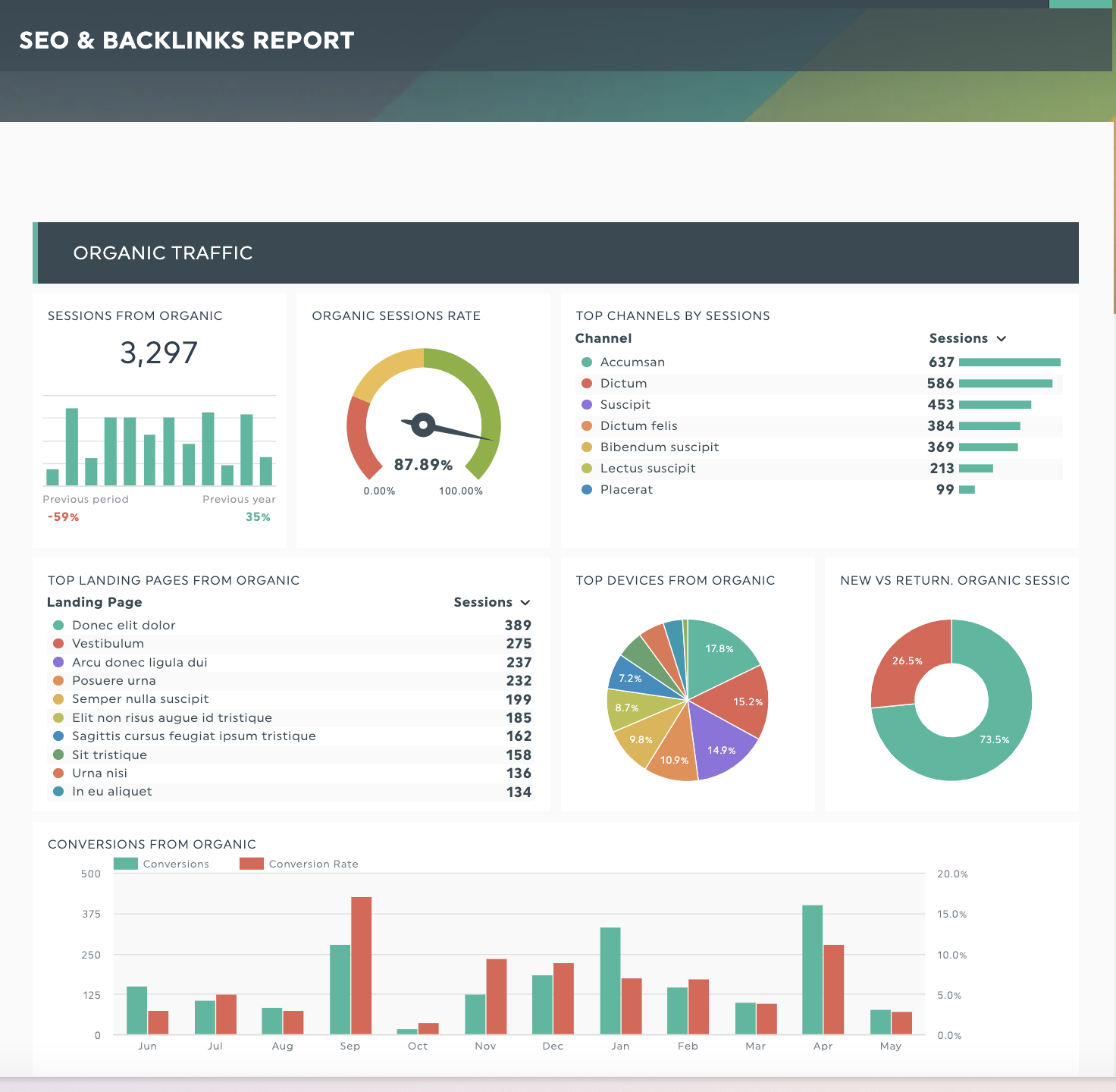
Obtenez votre modèle de présentation SEO avec vos propres données!
Lorsque vous travaillez avec des clients, ces présentations marketing peuvent vous aider :
- Sensibiliser les parties prenantes au fonctionnement des moteurs de recherche et à la manière dont elles peuvent bénéficier de vos services de référencement.
- Réaliser un audit SEO et mettre en évidence les opportunités de croissance
- Expliquer son approche de travail avant de commencer un nouveau projet
- Examiner les résultats des clients lors d'un examen trimestriel des activités ou d'un rapport mensuel.
Pourquoi ajouter des présentations sur le référencement à votre répertoire de rapports ?
Les présentations de référencement sont un excellent moyen de montrer la valeur du travail de votre agence de référencement. Des rapports réguliers témoignent de la transparence de votre travail et constituent un excellent moyen de gagner la confiance de vos clients. Mais pourquoi les ajouter à votre boîte à outils ? Voici trois façons dont elles peuvent s'avérer utiles.
I. COMMUNIQUER LA STRATÉGIE SEO ET DÉFINIR LES ATTENTES
Commencer un nouveau projet ensemble est à la fois excitant et angoissant.
Vos clients veulent savoir sur quoi vous allez travailler et quels résultats ils peuvent attendre. Pour faciliter la collaboration, établissez un climat de confiance et fixez des attentes réalistes avec votre nouveau client. Votre présentation sur le référencement pourrait inclure une feuille de route décrivant chaque composante de votre stratégie de référencement, un calendrier estimatif et les ressources nécessaires pour chaque tâche afin de démarrer un nouveau projet du bon pied.
II. EXPLIQUER AUX PARTIES PRENANTES CE QU'EST LE SEO
Les personnes qui ne sont pas familiarisées avec le marketing numérique peuvent avoir du mal à comprendre le référencement. Les présentations sur le référencement peuvent expliquer comment votre travail s'inscrit dans la stratégie marketing de votre client. Elles peuvent également faire le lien entre vos efforts et les paramètres auxquels vos clients s'intéressent.
Par exemple, vous pouvez expliquer à un responsable des ventes comment le référencement augmente le pipeline de vente ou a un coût par lead plus faible que d'autres canaux. Cette approche rend vos informations plus compréhensibles pour eux, car elles sont directement liées à leurs objectifs.
III. METTRE EN ÉVIDENCE LES RÉSULTATS DU SEO ET LE ROI
Il faut en moyenne 6 à 12 mois pour que les initiatives de référencement donnent des résultats significatifs. résultats.
C'est une longue période et vos clients auront besoin d'être rassurés en cours de route. Des présentations et des rapports réguliers permettent de tenir les clients au courant des derniers résultats et du retour sur investissement. Par exemple, vous pouvez montrer à vos clients l'impact de votre travail en mettant en évidence l'évolution de la visibilité dans les moteurs de recherche ou des taux de conversion organique depuis que vous avez commencé à travailler avec eux.
Que faut-il inclure dans votre présentation sur le référencement ?
Dès le départ, une présentation sur le référencement répond à ces questions.
- Que prévoyez-vous de faire ? (par exemple, aperçu de la stratégie de référencement, portée du projet et recommandations pour atteindre les objectifs du client)
- Pourquoi le faites-vous ? (Résultats de la recherche de mots-clés, de l'audit du site, de l'analyse des concurrents et de l'analyse des données)
- Comment procédez-vous ? (Prochaines étapes concrètes étayées par des données et des analyses le cas échéant)
- Comment mesurez-vous les progrès réalisés ? (indicateurs de performance suivis, fréquence des rapports)
Voici ce qu'il faut inclure dans chaque élément et une suggestion de structure à utiliser.
1. Introduction et résumé
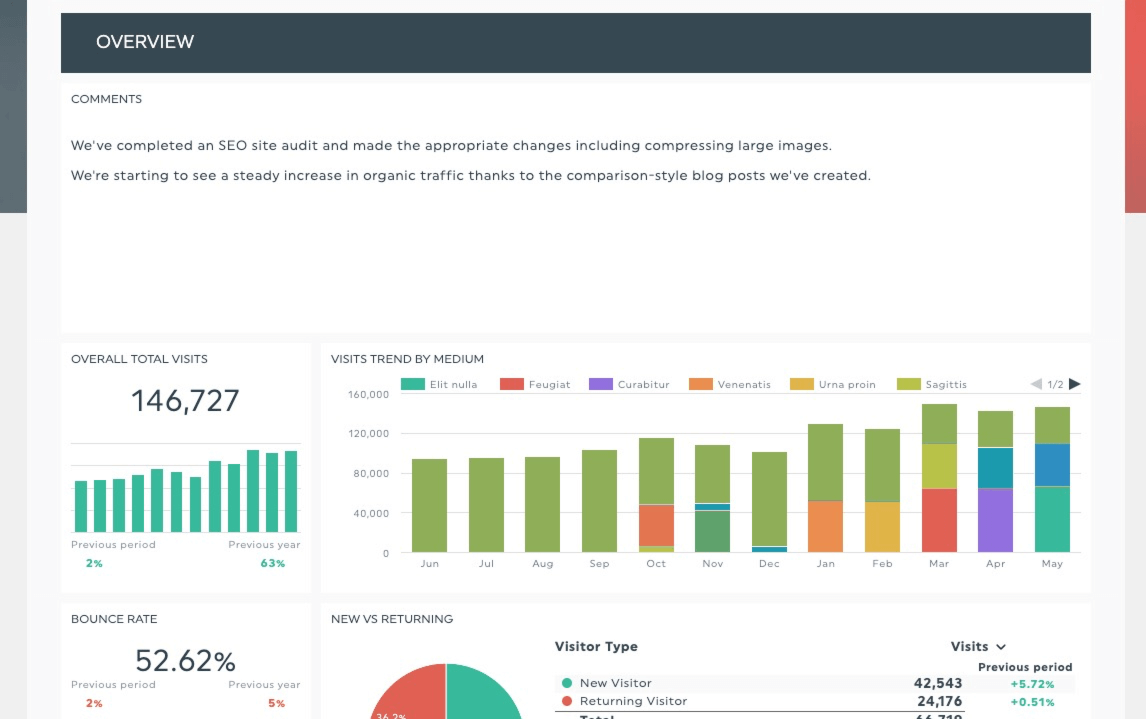
L'introduction donne un aperçu concis du sujet. Elle clarifie vos principaux points, ce qui permet aux clients d'assimiler votre rapport. Dressez la liste des objectifs de votre plan de référencement et de ce que vous souhaitez couvrir dans la présentation.
Sur une diapositive ou une page séparée, vous devez décrire brièvement les membres de votre équipe et leur expérience. Cela aidera votre client à mettre des visages sur des noms et le rassurera sur le fait qu'il est entre de bonnes mains.
2. Aperçu de la stratégie de référencement
Après l'introduction, vous donnerez à votre client une vue d'ensemble de la stratégie que vous proposez. Par exemple, vous pouvez inclure
- Une description concise de la stratégie de référencement
- Un audit du site et des recherches pour mettre en évidence les possibilités de croissance
- Initiatives clés en matière de référencement
- Des indicateurs de performance pour mesurer les progrès
- Cadence et calendrier des rapports
Kayden Roberts, CMO chez CamGoKayden Roberts, CMO de CamGo, décrit ici son approche des présentations de référencement :
J'aime structurer la présentation en commençant par une vue d'ensemble - comment le référencement est directement lié aux objectifs commerciaux du client. Il est facile de s'embourber dans les métriques, mais les clients s'intéressent avant tout à la manière dont le référencement contribue à leurs résultats. C'est pourquoi j'articule toujours la conversation autour d'objectifs commerciaux clés tels que l'augmentation du trafic organique, l'amélioration des conversions ou l'accroissement de la visibilité de produits ou de services spécifiques.
Kayden utilise également le data storytelling pour centrer la présentation sur les besoins du client. Voici comment il s'exprime :
L'une des approches créatives que nous avons utilisées consiste à incorporer des éléments visuels narratifs. Au lieu d'afficher des tableaux et des graphiques, je raconte une histoire avec les données. Par exemple, il montre comment une campagne de référencement a commencé avec un faible classement et s'est développée au fil du temps grâce à une optimisation ciblée des mots clés et à des efforts de création de liens.
Ensuite, nous verrons comment proposer une initiative de référencement à votre client en utilisant la recherche de mots-clés et l'analyse de la concurrence pour informer vos recommandations.
3. Recherche de mots-clés
La recherche de mots-clés et d'audience constitue la base de la stratégie de référencement. Il s'agit ici de présenter des opportunités de mots-clés basées sur :
- Marché et potentiel commercial
- Recherche sur le public cible
- Recherche de concurrents
- Performance du site web actuel
Pour chaque mot-clé, présentez des données telles que le volume de recherche et le niveau de concurrence à battre. Vous montrerez ainsi à votre client sur quoi vous vous concentrerez ensuite et pourquoi c'est important pour son entreprise.
Lire la suite : Un guide sur la recherche de mots-clés et des concurrents avec DashThis, ainsi qu'une liste d'outils suggérés pour visualiser vos résultats en matière de référencement.
DashThis vous permet de saisir des données provenant de tous vos outils de mots-clés, comme Ahrefs, Moz ou SEMRush, dans un seul rapport de classement des mots-clés. Voici un modèle que vous pouvez visualiser en direct avec vos propres données.
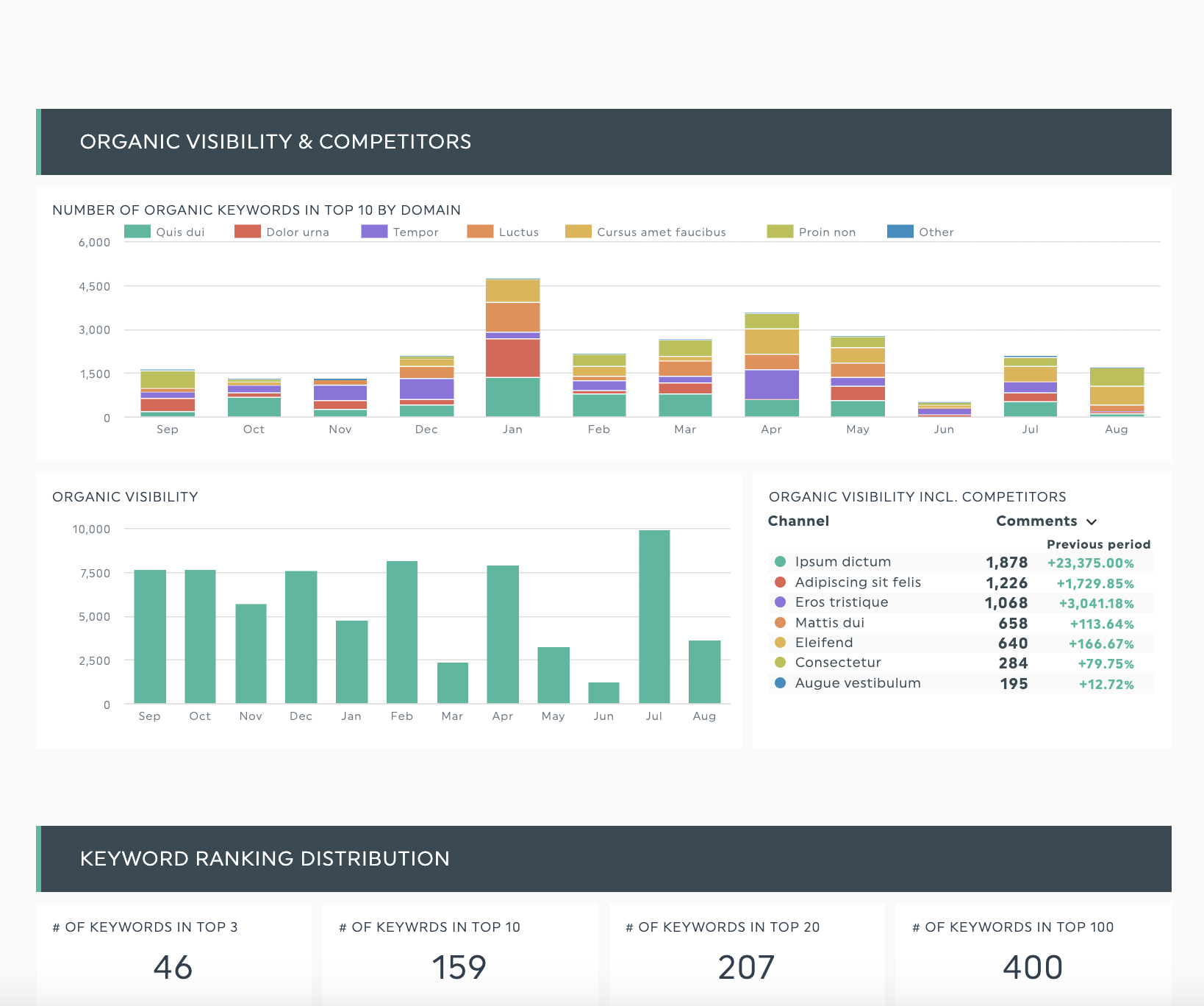
Une fois que vous avez compilé vos recherches, résumez ces résultats en ajoutant une note à ces mesures ou en écrivant quelques points clés dans une boîte de commentaires.
4. Recherche de concurrents en matière de référencement
Outre les données relatives au classement des mots clés, montrez à votre client à quel point les classements de recherche sont concurrentiels pour son secteur d'activité et le mot clé ciblé. Décrivez 3 à 4 concurrents clés, évaluez leurs sites web et déterminez dans quelle mesure il est difficile de les surclasser.
Vous pouvez également comparer les performances actuelles de votre client à celles de ses principaux concurrents. Comparez des paramètres tels que le classement des mots clés, le trafic organique et les domaines de référence. Ces mesures indiquent les domaines de croissance et jettent les bases de la stratégie de référencement que vous proposez.
5. Initiatives clés en matière de référencement
La recherche de mots-clés et l'analyse de la concurrence ayant montré le "pourquoi", nous passons maintenant au "comment".
Cette section sur la mise en œuvre constitue l'essentiel de votre présentation. Vous discuterez des stratégies de référencement que vous recommandez et que vous mettez en œuvre pour atteindre les objectifs de vos clients. Utilisez vos conclusions précédentes pour étayer chaque initiative que vous énoncez, en soulignant comment elles peuvent aider vos clients à atteindre leurs objectifs.
Conseil de pro : il est utile d'étayer ces résultats par des études de cas pertinentes. Elles vous permettent d'expliquer comment ces initiatives ont bénéficié à d'autres entreprises dans la même situation.
Il existe trois types d'activités de référencement sur lesquelles vous pouvez vous concentrer.
SEO ON-PAGE :
Ce type de référencement se concentre sur l'optimisation du contenu des pages web pour les moteurs de recherche
Exemples d'activités d'optimisation du référencement sur la page :
- Optimiser le contenu des sites web et des pages d'atterrissage existants
- Examinez la balise de titre de la page web et les méta-descriptions.
- Actualiser le classement et le contenu permanent pour améliorer le classement organique
- Créer un contenu de haute qualité pour se positionner sur de nouvelles opportunités de mots-clés
SEO OFF-PAGE :
Ce type de référencement se concentre sur les activités qui promeuvent votre site web sur l'internet.
Exemples d'initiatives d'optimisation hors page :
- Activités de construction de liens
- Marketing de contenu
- Contenu des médias sociaux comme LinkedIn et Instagram
- Mentions dans la presse
SEO TECHNIQUE :
Ces activités permettent aux moteurs de recherche de trouver, de comprendre et de référencer plus facilement votre contenu.
Exemples d'activités techniques de référencement :
- Amélioration de la vitesse des pages
- Amélioration de l'expérience utilisateur et de l'architecture du site
- Mise à niveau de la sécurité du site web
- Optimisation mobile
6. Mettre en évidence les indicateurs de performance SEO à suivre
Comment allez-vous mesurer les progrès accomplis dans la réalisation des objectifs de votre client, ou évaluer si vos efforts portent leurs fruits ?
Mesurer les SEO KPIs vous donne les réponses dont vous avez besoin. Reliez les performances à un indicateur pour chaque initiative que vous proposez.
Exemples d'indicateurs clés de performance en matière de référencement qui méritent d'être inclus dans votre présentation :
- Taux de conversion du trafic organique
- Coût par acquisition
- Volume du trafic organique sur le site web,
- Classement du site web du client dans les moteurs de recherche
- Visibilité sur les pages de résultats des moteurs de recherche (SERP)
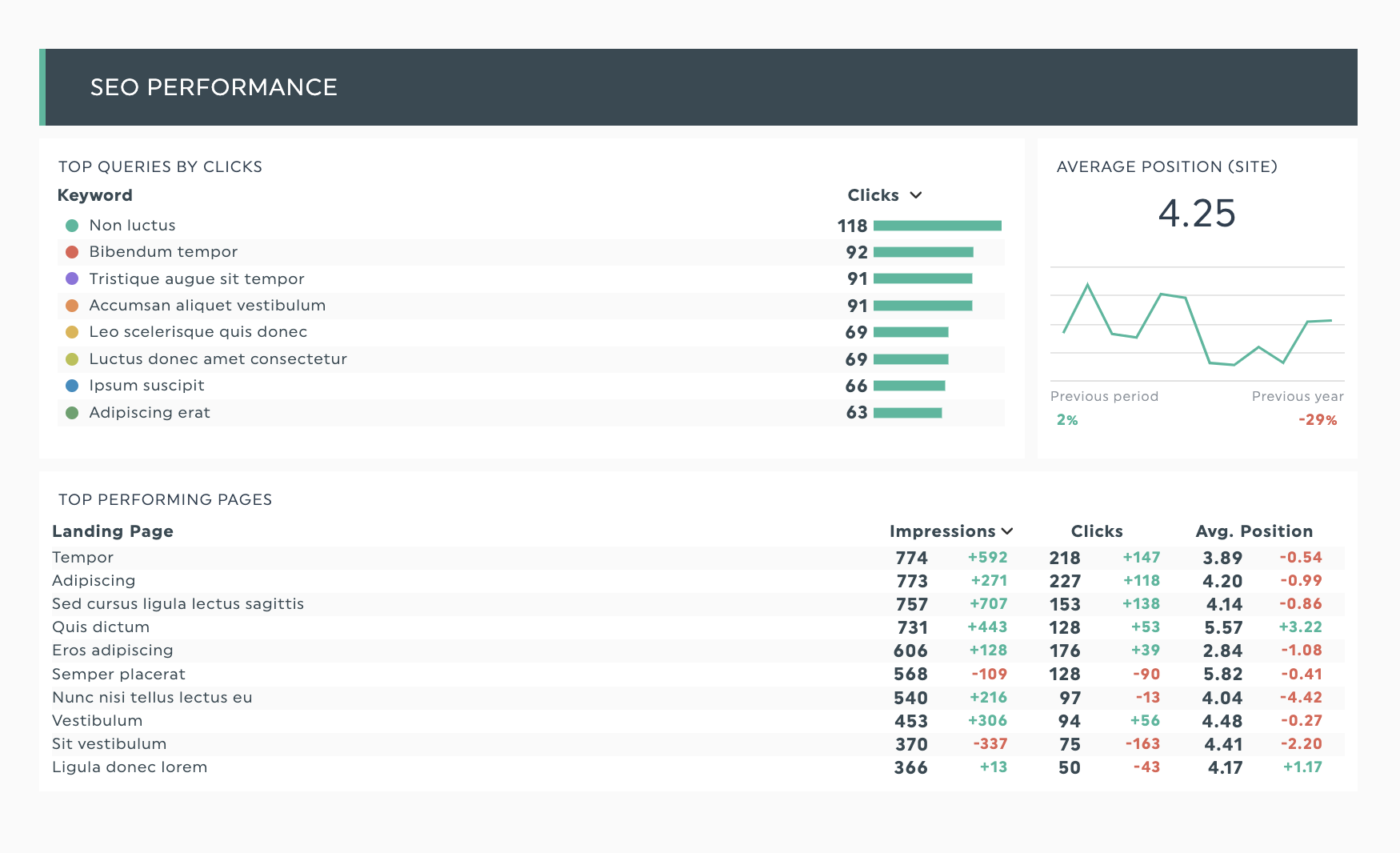
Mesures de performance SEO suivies dans DashThis. Obtenez ce rapport avec vos propres données !
Pour montrer les performances de votre client par rapport à ses concurrents, vous pouvez suivre des indicateurs tels que
- Nombre de mots-clés organiques dans les 10 premières positions par domaine
- Visibilité organique du site web
- Classement des pages
- Nombre de backlinks ou domaines de référence
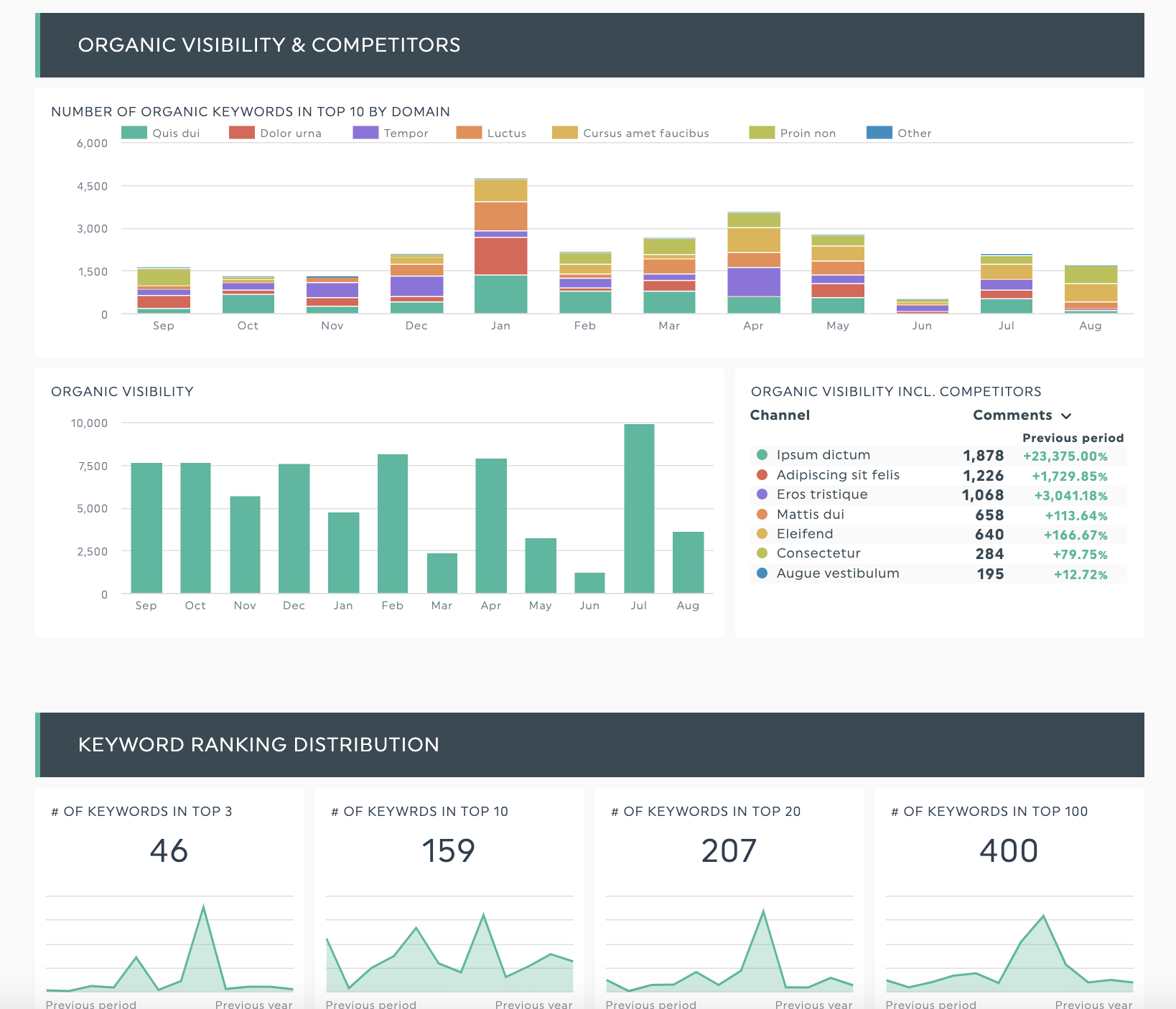
Modifiez cette section en fonction des objectifs que vous poursuivez et des stratégies de référencement que vous employez. Besoin de plus d'inspiration en matière d'indicateurs de performance ? Consultez la liste de DashThis de 100+ exemples d'indicateurs de performance clés.
7. Conclusion et prochaines étapes
La conclusion est le moment où vous laissez votre client inspiré et rassuré. C'est là que vous récapitulez les points clés et que vous décrivez les prochaines étapes. Pensez à ajouter un calendrier et des estimations de temps pour chaque activité afin de fixer les attentes de votre client.
"Ne lésinez pas sur la conclusion de votre présentation", déclare Marta Romaniakvice-présidente de la stratégie de marque mondiale chez Avenga. Elle précise :
"Nous terminons généralement par des réflexions sur ce qu'il faut faire ensuite. À mon avis, ce point, ainsi que la manière dont vous commencez, est un moment crucial de votre présentation. Vous devez convaincre le client que vous avez quelques longueurs d'avance et que, sur la base des résultats actuels, vous prévoyez d'en faire encore plus à l'avenir. En d'autres termes, la fin doit être une source d'inspiration !
Conseils pratiques pour présenter des projets de référencement à vos clients
Vous avez en main votre document de présentation sur le référencement - il est maintenant temps de réussir la présentation proprement dite. Gardez ces conseils à l'esprit lorsque vous préparez votre présentation.
Conseil n° 1 : définissez clairement l'objectif de votre présentation
Réfléchissez à l'objectif de votre présentation sur le référencement avant de la préparer. Votre objectif est-il d'informer votre public sur les dernières pratiques en matière de référencement ? Ou s'agit-il d'établir un argumentaire pour élargir la portée du projet ?
Ces deux objectifs nécessitent une approche différente de la présentation des informations. Par exemple, si vous vous concentrez sur l'éducation des parties prenantes, partagez :
- Pourquoi le référencement est efficace.
- Ce que font les concurrents de la marque en matière de référencement.
- Ce que vous devez faire ensuite.
Ou, si vous vous préparez à une revue de projet, concentrez-vous sur les résultats que vous avez obtenus. Vous pouvez, par exemple, comparer les indicateurs commerciaux d'aujourd'hui avec ceux d'il y a six mois.
Conseil de pro : Définissez un objectif évident pour votre présentation et faites-le figurer en haut de votre diaporama ou de votre rapport lorsque vous sélectionnez des indicateurs. Cela vous aidera à rester sur la bonne voie.
Conseil 2 : Adaptez votre présentation à votre public
Ensuite, adaptez votre présentation au niveau de connaissance et aux intérêts du public. Mettez-vous à la place du public et anticipez ses questions et préoccupations concernant votre présentation. Voici, par exemple, quelques questions que vous pouvez envisager de poser :
- Quels sont les indicateurs ou les résultats commerciaux qui intéressent ces personnes ?
- Qui sont les parties prenantes et qu'attendent-elles d'eux ?
- De quelle manière espèrent-ils que la présentation leur sera bénéfique ?
Il est tentant d'ajouter toutes les mesures de référencement et tous les facteurs de classement pour montrer tout votre travail, mais essayez d'y résister ! Cela ne fera que diluer votre message principal et le rendre plus difficile à suivre. Une question utile que vous pouvez vous poser lorsque vous ajoutez des informations :
"Ces informations répondent-elles aux principales préoccupations de mes parties prenantes ? Ou s'en écartent-elles ?
Conseil de pro : Faites de votre mieux pour simplifier les termes SEO complexes. Adaptez votre langage aux connaissances de votre public. Si vous devez utiliser des termes comme indexation ou expliquer la dernière mise à jour de l'algorithme qui affecte le classement de votre client dans les moteurs de recherche, définissez-les à l'aide d'une note. (Psst, nos notes et commentaires peut vous aider à ajouter une explication sans encombrer votre présentation).
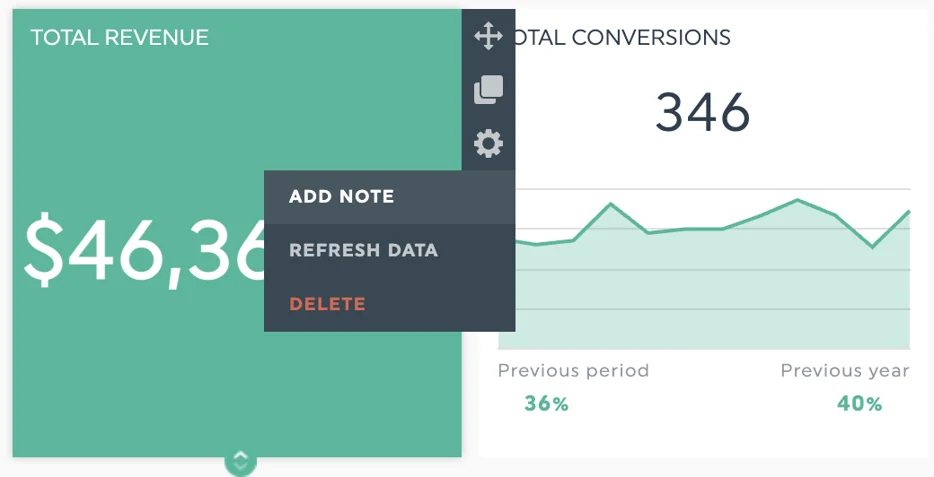
Conseil n° 3 : utiliser des aides visuelles
Que préférez-vous voir ? Des lignes de données Excel montrant les tendances du trafic organique au fil du temps, ou un graphique linéaire de la même tendance ?
Il y a de fortes chances que vous choisissiez le graphique.
Pourquoi ? Il est beaucoup plus facile d'assimiler les informations d'un seul coup d'œil lorsqu'elles sont présentées sous la forme d'un graphique. Les clients n'ont peut-être pas le temps de lire chaque détail de votre présentation sur le référencement. Les études de suivi oculaire montrent qu'ils sont plus enclins à parcourir les présentations et les rapports et à rechercher les informations qui les concernent.
Pour tenir compte du comportement de balayage, utilisez des tableaux et des titres pour guider l'œil de votre client vers ce qui est pertinent pour lui. Jetez un coup d'œil à ces exemples de tableaux que vous pouvez utiliser pour présenter vos informations.
Graphiques de jauge : Les jauges permettent de communiquer les progrès accomplis dans la réalisation des objectifs ou de visualiser les indicateurs clés de performance. Ainsi, si vous visez un taux de conversion organique, vous pouvez utiliser un tableau de bord pour suivre les progrès accomplis.
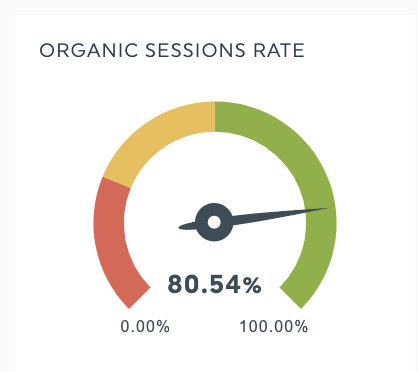
Diagrammes à barres : Suivre les indicateurs dans le temps. Vous pouvez utiliser des diagrammes à barres pour montrer les performances d'un ICP d'un mois sur l'autre ou d'une année sur l'autre. L'exemple ci-dessous le montre pour les conversions et les taux de conversion.

Graphiques linéaires : Utilisez-les pour suivre une mesure dans le temps, comme la position moyenne d'un site ou le classement d'un mot-clé dans les SERP.
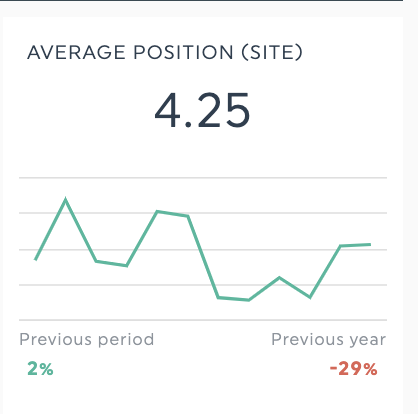
Le texte peut également faciliter la compréhension des données. Indiquez les axes d'un graphique linéaire, donnez un titre à vos graphiques et ajoutez une légende. Ces simples ajouts facilitent la compréhension de vos données.

Pour ajouter ou modifier un titre de graphique dans DashThis, il vous suffit d'aller dans Edit Widget > Basic Settings > Widget Title.
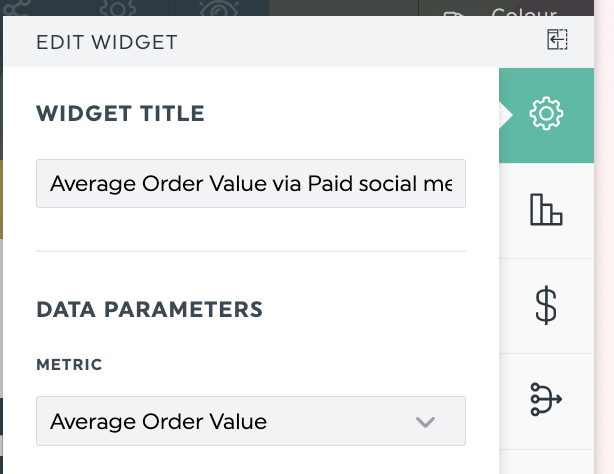
Conseil n° 4 : anticiper les questions courantes des clients
Lorsque vous présentez votre proposition ou votre rapport sur le référencement, les clients peuvent poser des questions.
Tout d'abord, ne paniquez pas ! Lorsqu'un client vous pose une question, il montre qu'il est intéressé par ce que vous avez à dire.
La préparation et la répétition sont utiles à cet égard. Référez-vous à l'exercice précédent et imaginez les questions que votre public pourrait vous poser. Par exemple, si vous vous adressez à un responsable du commerce électronique, anticipez les questions sur la manière dont le référencement augmente les ventes en ligne ou le taux de conversion.
Que diriez-vous de quelques questions spécifiques auxquelles vous pouvez vous attendre ? Nous avons demandé à des spécialistes du référencement et du marketing quelles étaient les questions qu'ils recevaient sur le référencement et comment ils y répondaient. Voici ce qu'ils ont à dire.
"Pourquoi notre classement ne s'améliore-t-il pas plus vite ? "J'explique toujours que le référencement est un jeu de longue haleine, en particulier pour les termes concurrentiels. Il faut parfois des mois pour obtenir des résultats, et les algorithmes de recherche changent régulièrement. Fixer d'emblée des délais réalistes a été essentiel pour gérer les attentes.
Tom Golubovich, responsable du marketing chez Ninja Transfers
Une question que l'on me pose souvent est la suivante : "Pourquoi ne sommes-nous pas encore classés pour ce mot-clé ?" J'explique les facteurs qui entrent en ligne de compte dans le classement - la concurrence, l'intention de recherche et les mises à jour des algorithmes - et je renforce l'idée que le référencement est une stratégie à long terme. Je les rassure également en soulignant les progrès constants réalisés dans d'autres domaines, en leur rappelant qu'un effort soutenu finira par porter ses fruits.
Ally MoisseResponsable de compte à Pearl Lemon Group Pearl Lemon Group
Comment DashThis peut vous aider à créer des présentations SEO en quelques minutes
Mettons en pratique tout ce que nous avons abordé grâce à ce guide étape par étape.

Obtenez votre modèle de rapport SEO avec vos propres données !
DashThis facilite la création de présentations SEO en quelques étapes seulement.
- Sélectionnez un modèle de rapport SEO prêt à l'emploi. Tous les modèles conviviaux comprennent des indicateurs clés de performance SEO prédéfinis, associés à une visualisation appropriée. Ainsi, vous ne manquerez aucune mesure importante. Vous pouvez également créer votre propre rapport si vous le souhaitez.
- Connectez vos outils de référencement (par exemple, Google Analytics, Ahrefs, Moz et autres) à DashThis.
- Organisez vos mesures grâce à l'interface "glisser-déposer" de DashThis.
- Créez un modèle à partir de la présentation sur laquelle vous avez travaillé
- Partagez votre présentation en la téléchargeant au format PDF ou planifiez un envoi régulier. envoi régulier à votre client
Apprendre mieux avec la vidéo ? Regardez cette vidéo pour apprendre à créer une présentation ou un rapport sur le référencement en seulement 5 minutes.
Automatisez vos rapports sur le référencement avec DashThis
Les présentations de référencement sont l'occasion de montrer l'expertise de votre agence. Elles expliquent pourquoi le référencement est pertinent pour les objectifs de votre client et décrivent votre approche de travail tout en indiquant clairement comment vous mesurez les progrès accomplis.
S'il y a une chose à retenir de cet article, c'est bien celle-ci : mettre l'accent sur la valeur commerciale de vos efforts de référencement. Votre client veut savoir comment votre travail de référencement peut résoudre ses problèmes. Répondez à cette question et il sera beaucoup plus facile d'établir la confiance et d'obtenir le soutien de la direction dont vous avez besoin pour votre travail.
Si vous avez besoin d'aide en matière de rapports et d'analyses, laissez DashThis vous aider ! DashThis est l'outil de tableau de bord SEO le plus accessible pour vous aider à visualiser vos données et analyses pour votre présentation SEO en quelques minutes.
Inscrivez-vous dès aujourd'hui pour un essai gratuit de 15 jours de DashThis.
Prêt à réussir votre présentation sur le référencement ?
Lire la suite
Ne manquez pas cette occasion !
Automatisez vos rapports !
Rassemblez toutes vos données marketing dans un seul rapport automatisé.
Essayer dashthis gratuitement

